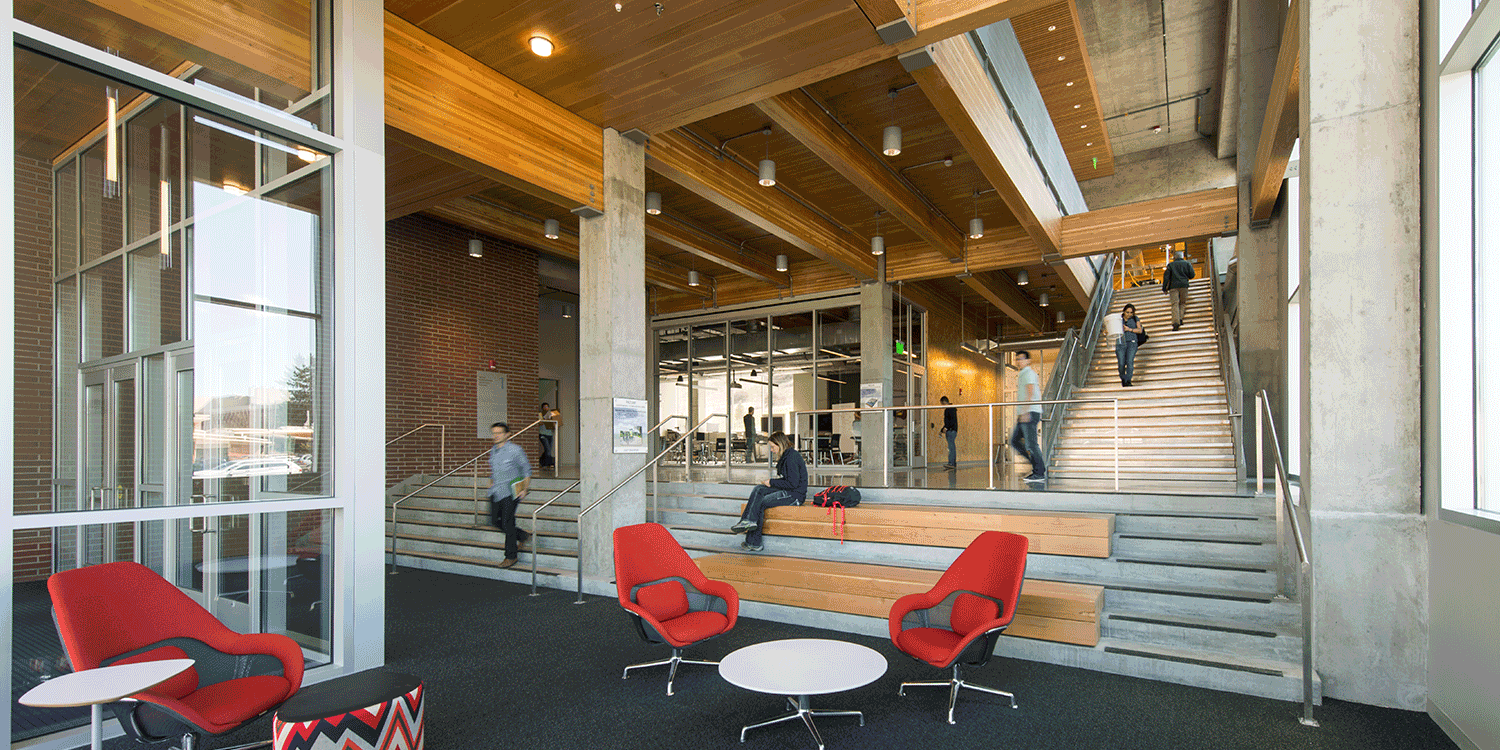FEATURE ARTICLE: Cross Laminated Timber

How it’s made (CLT 101)
Before we get ahead of ourselves, a quick recap: CLT is a prefabricated series of layered orthogonal planks, each glued to the one below. The result is a product that can compete with traditionalists like concrete and steel. As it becomes increasingly clear that building with CLT is a “when,” not an “if,” manufacturers are popping up in the Northwest and British Columbia, eager to become a part of what analysts project to become a $4 billion industry.
Benefits, why it’s wowing us.
CLT is undisputedly the most innovative thing happening with wood right now. As engineers, we’re excited by the prospect of a new material, especially one with the qualities of CLT. Here’s how we see CLT changing the game:
- CLT panels are five times lighter than concrete, and 14 times lighter than steel. This means less weight on the foundation and ground underneath (which is especially advantageous on sites with poor soil).
- Designed and detailed properly, the product saves time in construction via prefabrication, allowing it to compete cost-wise with steel and concrete.
- CLT is carbon-consuming and renewable. Instead of increasing the carbon footprint, building with wood creates a positive impact instead of emitting carbon with steel or concrete.
- It has significant architectural advantages. CLT can be left exposed, and allows for tall ceilings, open spaces and hidden connections.
- It’s beautiful and sustainable! And with the adoption of a new building material, we’ll see a new generation of creativity and design.
CLT, beyond borders.
In terms of mid- to high-rise wood construction utilizing CLT, Europe and Canada are far ahead of the U.S. That said, we’re making progress on many fronts. Oregon is leading the nation with a twelve-story, CLT, mixed-use development (the performance-based design is awaiting a building permit in Portland) and Southern Oregon is home to the nation’s first supplier of structural-certified CLT. The International Code Council has a Tall Wood Building ad hoc committee developing code updates for future mass timber high rises; a consortium of academics representing various U.S. universities, including UW and WSU, are completing a FEMA analysis to codify seismic coefficients for CLT shear walls; and CLT shear walls and connectors under seismic loading are experiencing significant testing in the Northwest.
Here in Washington, our timber legacy began more than a century ago with pioneers like Frederick Weyerhaeuser. Even so, we have yet to experience the timber revolution our neighbors in Oregon and British Columbia are promoting. It’s not only seismic considerations that complicate CLT’s progress in the Pacific Northwest. In general, politicians have been slower to lead, but encouragingly, we’re starting to see that change. Last month, the state senate reintroduced Senate Bill 5450 which instructs the Building Code Council to adopt new rules for CLT use in buildings. While a small step toward comprehensive codification, it’s most definitely a start.
What’s next for CLT?
CLT is undeniably attractive – from sustainability and economics, to aesthetics and design possibilities. It’s an elegant solution, but it’s not all-encompassing or right for every program. It must be chosen with intention, and with the right team to back it up.
It’s an elegant solution, but it’s not all-encompassing or right for every program. It must be chosen with intention, and with the right team to back it up. – Chris Duvall, Principal
As we continue to study and execute CLT projects, we’ve identified key commonalities of successful projects. Each starts with a highly motivated owner who is brave enough to break through barriers. Then, the team commits to CLT early in design, ensuring there’s time to confront and surpass obstacles along the way. That team must be multidisciplinary, including contractors, building officials and fire marshals. The construction team is particularly important, given the industry’s common resistance to change.
Where do we see CLT best fitting into the Seattle-scape? Put simply, in structures between 85 and 160 feet tall. Seems specific? It is. Seattle urban planning has an inherent gap here, and it seems CLT is the perfect, economically-responsible solution for this zone.
Coughlin Porter Lundeen at the forefront.
Coughlin Porter Lundeen is an active proponent of CLT’s development, both locally and nationally. In addition to using CLT and other mass timber products on several projects, our team regularly participates in mass timber workshops, contributes to studies and research projects, and supports an internal task team. We’ve presented at several national seminars and have successfully proposed alternative building materials to local jurisdictions, including Seattle, for structural systems not currently pre-approved by the building code. We’re excited for CLT’s continued development, and are committed to contributing to the conversation in the Pacific Northwest and beyond.